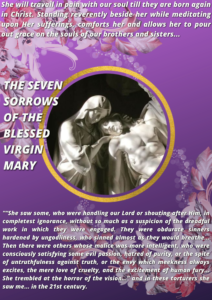Twice during the liturgical year, the Church honors the sorrows and the compassion of Our Lady at the foot of the Cross.
Christians surely have a duty to the Blessed Virgin Mary to honor with unceasing and affectionate zeal, as the sons of this most sweet Mother, the memory of the bitter sorrows she bore with admirable courage and invincible constancy, especially as she stood at the foot of Jesus’ Cross and offered them to the Eternal Father for their salvation. They should make this precept given by the holy Tobias to his son with regards to his mother their own: ‘Thou must be mindful what and how great perils she suffered for thee in her womb’ Tob. 4:4). What refuge, what consolation can we not promise ourselves and hope for from the Virgin Mary in our adversities, if we desire spontaneously to participate in her anguish and sufferings! Where could we find a more effective help in stirring up in our heart that sorrow so justly demanded by God to have mercy upon us, than in the loving and repeated meditation of Mary’s Sorrows?



